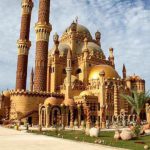Everything You Wanted to Know About SALADIN CITADEL
We’re going to know everything about Saladin Citadel in detail through this blog post from the FTS press.
The Citadel of Saladin: Egypt’s tourist destinations aren’t just pharaonic. Cairo, Egypt’s capital, in particular, combines numerous pharaonic, Islamic, Coptic, modern, as well as Christian elements. In the Medieval Era, the Islamic Arabs arrived in Egypt and began building their human civilization. Cairo is recognized as “The City of a Thousand Minarets” because of the abundance of Islamic sites, particularly mosques.
The Citadel of Saladin is a well-known Islamic site (it is also known by the name The Citadel of Cairo). The Citadel is a popular tourist attraction in Cairo due to its historical significance and design in a way. The Citadel was regarded as just a city within a city.
Salah El Din Al-Ayyubi was a man named Salah El Din Al-Ayyubi
Salah El-Din (recognized by European historians as Saladin) deposed the Fatimid dynasty in 1171 AD, trying to establish a fresh Sunni Ayyubid Islamic state. Provided the threat of attack by European crusader armies, Saladin sought to upgrade the city’s fortresses, and then in 1176 AD, he began building a wall that would enclose both Al-Qahira (now Islamic) as well as Fustat (Old Cairo).
Salah El-Din was born in Tikrit, Iraq, in 1137 AD, and researched the Quran, theology, astronomy, mathematics, and law. As a military member at the time, he was given training by his uncle, Zengid Dynasty commanding officer Asad-al-Din Shirkoh.
During military actions, Salah El-Din was able to take on leadership roles.
Mosque of Muhammed Ali
Once Muhammed Ali rose to power, he has been resolute to eliminate the Mamluks, who’d already ruled Egypt for 600 years before him, as well as torn down their palaces inside the fortress. He also constructed one of Cairo’s most well-known landmarks.
His Alabaster Mosque, erected in memory of a late son, towers over the remainder of the complicated. The side profile of the building is by far the most prominent feature of Cairo’s eastern skyline. In addition to the above-mentioned mosques, the Citadel houses the National Army Museum, which is filled with uniforms as well as weapons from Egypt’s lengthy tradition, a Police Museum, and other museums devoted solely to Muhammed Ali’s palace.
A 3rd mosque can be found in the Northern Casing, the behind National Military Museum. Suleiman Pasha Mosque is not as big as Muhamed Ali or Al-Nasir Mosques, but it is ornately decorated and a lovely instance of an Ottoman-style mosque.
Notwithstanding this, the high point of the Citadel may well be the perspective it provides of Cairo. Searching out from the city, one that’s why it was given the nickname “The City of a Thousand Minarets,” but on a straightforward day, one could even see the overview of the Giza Pyramids in the range.
Saladin Citadel ‘s Building
The Citadel was constructed among Cairo (the Fatimid capital) and Fustat (the ancient capital for 500 years) to serve as a refuge once enemies decided to take control of the city. It was constructed high on Mount Moqatam so that it could be seen wherever in Old Cairo. The viewpoints of Cairo from the Citadel’s southern wing are spectacular.
The Citadel is divided into two major sections: the southern part (as the king’s house with a large palace) and the northern part (as a military fort with great walls guarded north and east sides).
The Citadel was encircled by many walls
Within the Citadel
Since the Citadel’s building projects, kings, as well as rulers, have built structures on it.
-The most well-known structure in the Citadel is Muhammad Ali’s Mosque. The Alabaster Mosque is its official name. Muhammad Ali constructed it between 1830 and 1849. It is divided into two sections: Bait Al-Sala (prayer area) and Al-Sahn (great courtyard of ablution).
-Qaser Al-Gawhara, also recognized as the Palace of Jewels. It was decided to name it after Muhammad Ali’s wife’s name (Gawhara). There is Muhammad Ali’s home there. In 1814, it was constructed in the Ottoman style for the southern part of the country of the Citadel.
- -In 1318, the Citadel’s first structure was the Mosque of El-Naser Muhammad. It was regarded as Cairo’s official mosque.
- -Additional tourist spots within the Citadel;
- -Muhammad Ali constructed the Military Museum, in which he studies Egypt’s military history.
- -The photos of Reya and Sekina were found in the Police Museum (the serial killers in the 20th century in Alexandria).
- -Muhammad Ali visited the Museum of Carriages.
- -In 1318, the Citadel’s first structure was the Mosque of El-Naser Muhammad. It was regarded as Cairo’s formal mosque.
- -The Soliman Pacha Mosque was constructed during the Ottoman dynasty.
- -Sultan Hassan Mosque as well as Al-Refai Mosque
Is the Saladin Citadel available to the public?
The Egyptian government set up a large portion of the Citadel to the public in 1983 and initiated repair and maintenance programs to transfer some of its old buildings into museums, however, the military still has a presence there. It is now a popular tourist destination for both Egyptians and foreign nationals. Saladin’s Well in pass.
Why is Saladin’s well so well-known?
It has become a popular tourist destination for both Egyptians and foreign nationals. Saladin’s Well in pass. Saladin constructed an 85-meter (280-foot) deep well generally recognized as the Well of Joseph (or Bir Yusuf) to deliver water to the Citadel, so-named because of Saladin’s surname, Yousif is the Arabic equal of Joseph.
Midan al-Qal’a (Saladin Square) is what it’s called.
It is now inhabited by the Citadel Square (Midan al-Qal’a) or Saladin Square (Midan Salah ad-Din), which would be flanked by the huge mosques of Sultan Hassan and al-Rifa’i. The Eagle of Saladin from the citadel had become Egypt’s as well as other Arab states’ coat of arms.
In Cairo, what also does Saladin think up?
furthermore, he designed an 85-meter-deep well dug out from the rock known as the Yusuf Well, and a scheme of aqueducts that brought water all through the city. The Citadel of Saladin, located on the Mokattam Hills in Islamic Cairo, has been one of the country’s most significant medieval cities.
Look here; 7 Top Attractions in Sharm el-Sheikh
Midan al-Qal’a (Saladin Square) is what it’s called?
It is now inhabited by the Citadel Square (Midan al-Qal’a) or Saladin Square (Midan Salah ad-Din), which would be flanked by the huge mosques of Sultan Hassan and al-Rifa’i. The Eagle of Saladin from the citadel had become Egypt’s as well as other Arab states’ coat of arms.
Look here; Cairo sights to see all the time 2022
In Cairo, what also does Saladin think up?
furthermore, he designed an 85-meter-deep well dug out from the rock known as the Yusuf Well, and a scheme of aqueducts that brought water all through the city. The Citadel of Saladin, located on the Mokattam Hills in Islamic Cairo, has been one of the country’s most significant medieval cities.
What contribution did Saladin make to Islam?
Saladin, a Sunni Muslim of Kurdish descent, led this same Muslim military campaign against the Crusader states in the Middle east. His sultanate would include Egypt, Syria, Upper Mesopotamia, the Hejaz, Yemen, as well as other parts of North Africa at its peak.
How also does Saladin reestablish Egypt’s Abbasid Caliphate?
According to Imad ad-Din, Nur ad-Din decided to write to Saladin in June 1171, urging him to restore the Abbasid caliphate in Egypt, of the kind that Saladin did two months later after extra encouraging words from Najm ad-Din al-Khabushani, the Shafi’i faqih, who was firmly opposed to Shia rule in the country.
How profound is Saladin’s citadel in Egypt?
It was 90 feet deep and a true marvel dug inside the Mokatam Mountain’s toughest rocks. The Citadel of Saladin in Cairo, with its strategic position and a bird’s eye display of the two nearest cities at the time, Fustat and Cairo, is viewed as one of the most graceful fortifications to be built during the Middle Ages.
Saladin’s Method of Providing Water to the Citadel
Once you stroll through Saladin citadel, you would then come across a depth well known as the Joseph Well. Saladin directed that this well be dug to provide water to the military men and residents of his castle on the occasion of a siege.
The other again you will see originally belonged to Al-Nasir Muhammad Ibn Qalawun, who took control of The region in 1293. It was constructed because the first well could not generate enough water for the number of individuals and animals who lived within the castle.
A Significant National Historic Occurrence Saladin’s Citadel (Saladin’s Citadel) Cairo was present
Numerous historical incidents happened at the Citadel of Saladin during the Ayyubid as well as Mamluk periods. Even during the French invasion of Egypt, Mohammed Ali ruled Egypt from The Castle, and he dedicated the most heinous crime in history, the castle mass killing, to let go Egypt of the Mamelukes.
In conclusion
We discovered the whole historical information about Saladin Citadel in detail through the essential previous points, and we hope you like it too much lovely mate!
Please feel free to reach out with us, one you want to try a trip to Saladin Citadel in Cairo.








